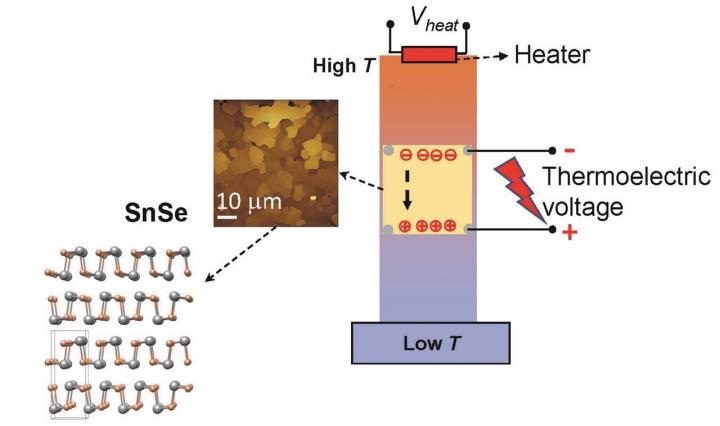Exploring the thermoelectric properties of SnSe

US researchers discover that nanometer-thick SnSe in thin films of connected 'nanoflakes' shows promise for thermoelectric energy conversion
Single crystal tin selenide (SnSe) is not only a semiconductor but also a good thermoelectric material that can directly convert waste heat to electrical energy or be used for cooling.
When a group of researchers from Case Western Reserve University in Cleveland, Ohio, saw the graphene-like layered crystal structure of SnSe, they recognised this material's potential to be fabricated in nanostructure forms. The group has just reported the results in the Journal of Applied Physics.
The group's work centres on the thermoelectric effect. They study how the temperature difference in a material can cause charge carriers - electrons or holes - to redistribute and generate a voltage across the material, converting thermal energy into electricity.
"Applying a voltage on a thermoelectric material can also lead to a temperature gradient, which means you can use thermoelectric materials for cooling," said Xuan Gao, an associate professor at Case Western.
"Generally, materials with a high figure of merit have high electrical conductivity, a high Seebeck coefficient - generated voltage per Kelvin of temperature difference within a material - and low thermal conductivity," he said.
A thermoelectric figure of merit, ZT, indicates how efficiently a material converts thermal energy to electrical energy. The group's work focuses on the power factor, which is proportional to ZT and indicates a material's ability to convert energy, so they measured the power factor of the materials they made.
To grow SnSe nanostructures, they used a CVD process. They thermally evaporated a tin selenide powder source inside an evacuated quartz tube. Tin and selenium atoms react on a silicon or mica growth wafer placed at the low-temperature zone of the quartz tube. This causes SnSe nanoflakes to form on the surface of the wafer. Adding a dopant element like silver to SnSe thin films during material synthesis can further optimize its thermoelectric properties.
At the start, "the nanostructure SnSe thin films we fabricated had a power factor of only ~5 percent of that of single crystal SnSe at room temperature," said Shuhao Liu, an author on the paper. But, after trying a variety of dopants to improve the material's power factor, they determined that "silver was the most effective - resulting in a 300 percent power factor improvement compared to undoped samples," Liu said. "The silver-doped SnSe nanostructured thin film holds promise for a high figure of merit."
In the future, the researcher hope that SnSe nanostructures and thin films may be useful for miniaturised, environmentally friendly, low-cost thermoelectric and cooling devices.
'Nanostructured SnSe: Synthesis, doping and thermoelectric properties' by Shuhao Liu et al; Journal of Applied Physics, March 20, 2018


































